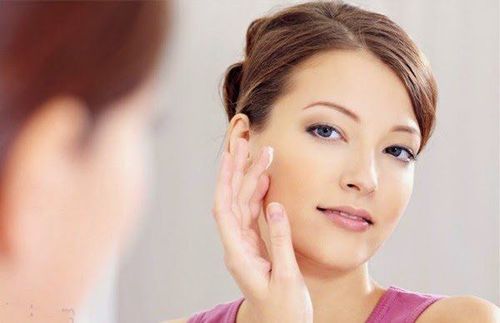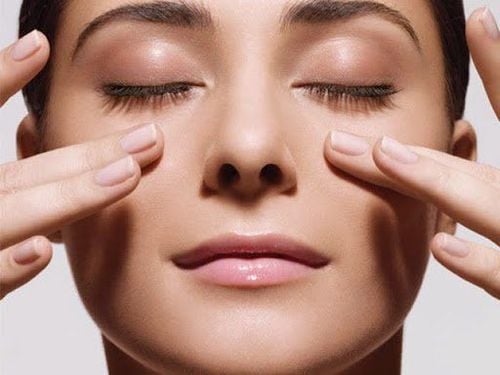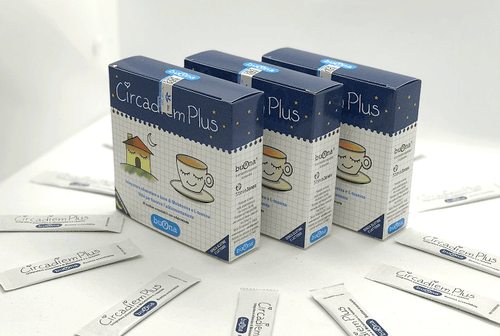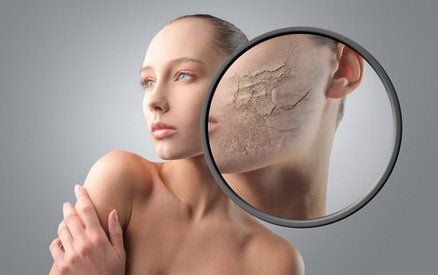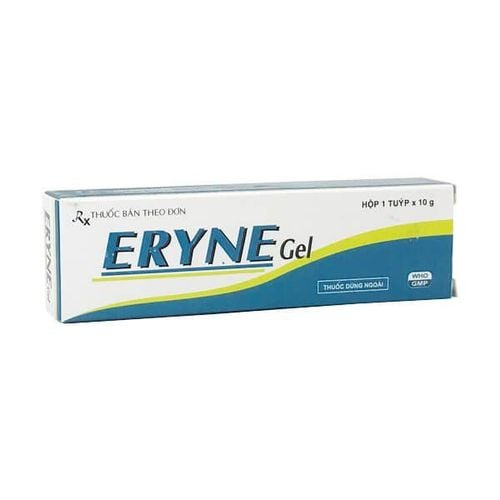This is an automatically translated article.
Over time as we age, the structure of the skin will gradually change. At the age of 40, most of us experience aging and wrinkles around the eyes, sagging lines and wrinkles. The skin aging process is the result of a combination of internal and external factors.1. What is skin aging, volume loss?
Skin aging is an unavoidable physiological phenomenon and none of us want to encounter it. The speed and timing of the onset of signs of aging such as wrinkles around the eyes and loss of collagen in the skin is not the same for everyone. Because the cause of aging has the simultaneous contribution of external factors and internal factors in the body.
The way we age is partly due to the influence of genetic factors. This intrinsic aging combined with environmental and lifestyle factors triggers the deterioration of key skin processes and functions. It is this that is responsible for the most visible signs of aging: wrinkles around the eyes, wrinkles around the corners of the mouth, sagging skin, loss of volume and loss of collagen in the skin and inherent elasticity.
Sagging skin is caused by a decrease in the number of cells produced. This loss along with wrinkles, loss of radiance and elasticity, causes facial skin to begin to age. It is not easy to quantify the loss of volume and contour in the face. The first signs suggest that the lips lose volume, when applying lipstick, it is difficult to stick to the color, not smooth. Loss of facial volume tends to result in sagging skin, flat cheeks, and a "turkey neck" appearance. It changes the overall appearance, the face can look negative, sad or tired. Wrinkles that often develop between the nose and mouth, known as nasolabial folds, are also associated with sagging skin and loss of volume.
2. Recognizing signs and clinical symptoms of skin aging
The even distribution of volume on the facial skin when we are young creates a beautiful and attractive appearance. The key features of a youthful face can be clearly seen as part of the 'beauty triangle'. Those features include:
High cheekbones Full cheekbones Smooth skin Smooth, defined jawline These features combine to create a broader face shape and structure on the side. upper, tapering to the narrowest point at the chin. The overall look brings a sense of comfort and positivity. In short, the beauty triangle is associated with a youthful, positive appearance. As we age, signs of volume loss appear causing the triangle to be inverted. This is due to the following changes:
Wider and looser jawline Sagging skin leading to less defined facial contours Flatter cheeks Wrinkles appear above the forehead and eyebrows Lower corners of the mouth hollow area under the eyes and temples The combination of these elements creates an aged appearance. As seen here, the triangle is now upside down with a wider area towards the bottom of the face. As the volume decreases and the skin sags, the look of the face is altered. The person may look sad or stressed and this leads to inaccurate judgments about their mood or appearance.
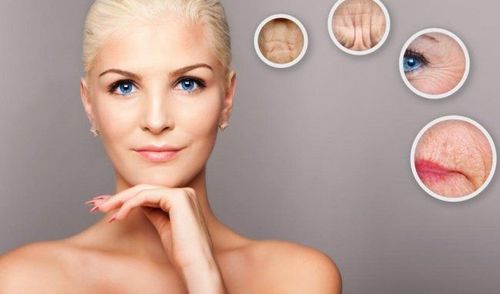
Mất collagen trên da gây nên tình trạng lão hóa da và mắt
3. Causes of skin aging and wrinkles around the eyes
A gradual decrease in 'fillers' to keep skin firm and feeling smooth leads to volume loss, less defined contours and sagging skin in different skin layers.
Epidermis: As we age, the outermost layers of skin produce less hyaluronic acid and less lipids. The skin's ability to bind moisture is impaired, leading to drier skin and, as a result, fine lines and wrinkles appear. The skin begins to sag, thin, and the texture can be dry and rough. Deeper layers of skin: here, there is a 1% annual loss of collagen, exacerbating the effect of skin thinning along with decreased levels of functional elastin. Since elastin is partly responsible for skin elasticity and strength, reducing the two together leads to sagging, less elastic skin. The volume-enhancing cells that keep the skin "filled" decrease in size and number, leading to a reduction in these layers. The result is skin that looks more sunken and lustrous, with flatter cheeks. Over time, blood flow that delivers nutrients slows down, leading to dull skin and a tendency to lose water and heal more slowly. The skin loses its elasticity even further and deep wrinkles begin to form.
It's not just genetics that affect how we age. There are a variety of internal and external factors that lead to loss of skin volume, including:
Hormonal changes: During puberty, estrogen levels increase. Skin is smooth and elastic and skin contours are defined. As we age, hormone levels decline and mass-producing cells decrease in both size and number, resulting in volume loss and less defined facial contours. Lifestyle: As part of the overall skin aging process, volume loss is also caused by external lifestyle factors, which contribute to wrinkles, loss of elasticity and radiance. Sunlight: Prolonged exposure to the sun can destroy collagen, damage skin structures and cause skin aging, due to the effects of ultraviolet rays. The result is premature skin aging caused by the sun. Smoking: Nicotine and other chemicals in tobacco further degrade the skin's collagen. These environmental factors combine to cause skin oxidation. This happens when molecules called "free radicals" form inside and attack cellular structures, including those that help skin look smooth and firm. Once the structure is weakened, collagen and elastin function decline, the skin aging process will accelerate. Visible signs include wrinkles around the eyes and other areas of the face, loss of volume, loss of elasticity and a less radiant appearance appearing on the skin's surface.
4. Solution for skin aging condition
Although skin aging, loss of collagen in the skin is a complex concern and in many ways unavoidable, some factors can be treated in several ways.
A daily skin care routine, using products specially formulated to treat volume loss, will give sagging skin the care it needs and can have a lifting effect. The following active ingredients (listed alphabetically) are used in anti-aging formulas to help address the causes of sagging skin, loss of volume, and poorly defined facial contours. .
Magnolol: Magnolol is a highly effective active ingredient extracted from the bark of the Magnolia tree and is also known as Magnolia Officinalis Bark Extract. It activates the secretion of a biologically active substance in the dermis layers of the skin, increases collagen synthesis and stimulates the number and size of volume-forming cells, which "plump" the reduced areas. Oligo Peptides: Oligo Peptides have the ability to stimulate the collagen network responsible for firmer skin structure. They also improve collagen synthesis in the dermis layers of the skin, thereby strengthening the connective tissue in the skin. They are extracted from the fruit and seeds of the Anise tree, which was originally grown for skin beauty and is also known as Pimpinella Anisum Fruit Extract. Hyaluronic Acid: Hyaluronic acid is formed by skin cells and is part of the connective tissue of the skin. One of their main functions is to retain moisture, and are capable of binding in water between 1,000 and 10,000 times its own weight (ie one gram of binding between one and ten liters). As we age, the skin's natural ability to produce Hyaluronic Acid decreases and wrinkles begin to form and deepen.

Lão hóa da khiến vùng mắt và da mặt hình thành nhiều nếp nhăn
5. Intensive treatments for aging skin
If you are still concerned about volume loss, your dermatologist may recommend one of the following treatments:
5.1 Non-invasive treatments
Thermowaves: Radiofrequency technology is used to heat the deep collagen layers of the skin. This heat promotes new collagen production and tightens existing collagen. The aim is to restore poorly defined facial contours. Ultrawaves: This treatment uses ultrasound waves to lift, firm, and tighten sagging skin. 5.2 Mild Invasive Treatments Fillers, injections are used for temporary volume replacement and for immediate, short-term results. Usually used on cheeks, temples and lips or under eyes. Injectable hyaluronic acid can also help smooth wrinkles.
5.4 Invasive Treatment Fat transfer surgery, which involves surgically removing fat from one area of the body and transplanting it into another. It is most commonly used to replace volume in the cheeks and provide long-lasting results. Post-surgery swelling is not unusual and treatment often requires a period of downtime before visible results are seen.
Aging is a natural human condition, but in order to slow down the skin aging process, the best way is to actively maintain a healthy diet and lifestyle, besides finding the Quality skincare products that complement your daily skin care routine.
Please dial HOTLINE for more information or register for an appointment HERE. Download MyVinmec app to make appointments faster and to manage your bookings easily.
Reference source: en.eucerin-me.com



